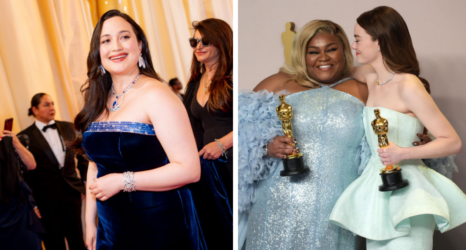Last week, the Geena Davis Institute on Gender in Media (GDIGM) hosted their 2nd Global Symposium in Los Angeles to share the findings of a new study examining how women are portrayed in films—and how often they get cast at all.
The event featured keynote speakers such as institute namesake Davis, study leader Dr. Stacy L. Smith, PhD. and GDIGM CEO Madeline Di Nonno, as well as two panels of entertainment industry professionals who not only critically analyzed the findings, but also discussed meaningful strategies to increase positive representation of women and girls in films and the industry globally.
So just how bad is it for women in film worldwide?
Smith and team analyzed 120 films with an MPAA rating of PG-13 or lower from 11 countries with fast-growing film industries—including Australia, Brazil, China, France, Germany, India, Japan, Russia, South Korea, the United Kingdom and the United States—with a theatrical release between Jan. 1, 2010 and May 1, 2013. Out of 5,799 speaking or named characters, only 30.9 percent were female compared to 69.1 percent male speaking or named characters. (That’s 2.24 males for every 1 female!) Moreover, women comprised only 23.3 percent of all protagonists.
Interestingly, films directed by women enjoyed 6.8 percent more females onscreen than did those without a female director attached. However, women comprise only 20.5 percent of filmmakers generally (compared to 79.5 percent male moviemakers) and specifically, only 7 percent of directors—meaning the likelihood of seeing a woman-helmed film with a woman lead is slim.
It gets worse.
Despite the fact that women make up 39.8 percent of the global paid workforce, onscreen only 22.5 percent of the characters women play are employed. Moreover, of the jobs female characters did work onscreen, only 13.9 percent of them were CEOs (compared to men’s 86.1 percent), 9.5 percent politicians (versus 90.5 percent of men) and zero (!) percent law partners and religious leaders.
The study also found that women are over two times more likely than men to be shown onscreen in sexually revealing attire (24 percent v. 9.4 percent), as thin (38.5 percent v. 15.7 percent) and partially or fully naked (24.2 percent v. 11.5 percent). Ugh.
But there is hope!
Despite the fact “the ratio of male and female characters in films has been exactly the same since 1946,” Davis insists it is within our power to change that—right now!
Said Davis at the event in Los Angeles,
In all the spheres of society where there’s a huge gender imbalance still, the one area where there’s gender imbalance we can fix overnight is onscreen. Whatever movie you are making, add more female characters. Before you shoot it, before you cast, look at it and see how you can add more female characters. Change what they do, change what they want. Just go through and cross out a bunch of first names of characters and put a female name instead.
Davis adds, “I don’t want to change anything about the freedom and creativity of the kind of work we do. I’m only talking about getting rid of the current message that is there: The message that women and girls are not the equal of men and boys.”
And Davis and GDIGM are already making a difference. An impact study conducted by the Davis Institute found that of those industry executives familiar with GDIGM’s message, 68 percent have applied the information to two or more projects they’ve completed or are currently working on, and 41 percent have applied it to three or more projects. When asked what changed about their projects, over a quarter reported amending the occupations of their female characters and nearly one fifth modified story development and added more women to secondary character roles.
Most of the panelists—including a number of Hollywood heavyweights such as Maleficent screenwriter Linda Woolverton, Mandalay Pictures and Women In Film President Cathy Schulman, and Dreamworks producer Kristine Belson—believe the tide is turning, at least in the executive suite.
“A lot of it is just hiring somebody who is willing to hire women,” says Belson, who gave a shout-out to Dreamworks Animation CEO Jeffrey Katzenberg for his willingness to give employment opportunities to women in the industry.
Adds Smith, “What we do see at a couple places around is some extremely sympathetic men. We have diversity initiatives going on at different multinationals around town and we’re starting to see progress shift in ways … but we’re a long way from not being white and male.”
Woolverton, whose first job, coincidentally, was given to her by Katzenberg, likened working in Hollywood as a woman to going into battle. “I had an image for myself everyday: putting on armor. I’m going to go out and I’m going to fight the fight.”
With the Geena Davis Institute on Gender in Media in our corner, we can’t lose!
Get Ms. in your inbox! Click here to sign up for the Ms. newsletter.
Photo courtesy of Flickr user EyesOnFire89 licensed under Creative Commons 2.0





